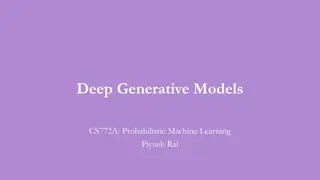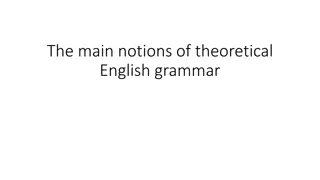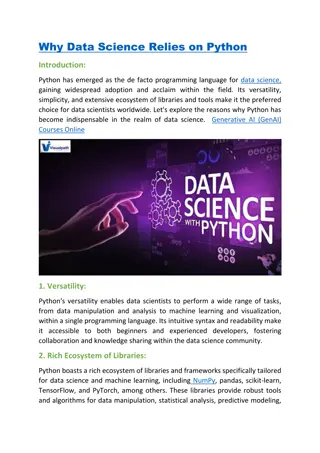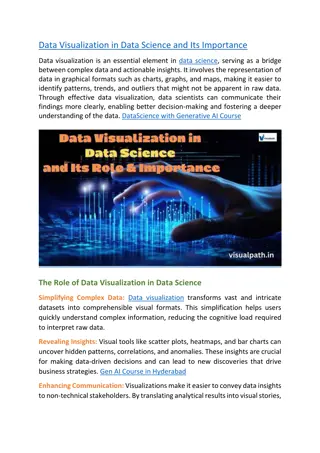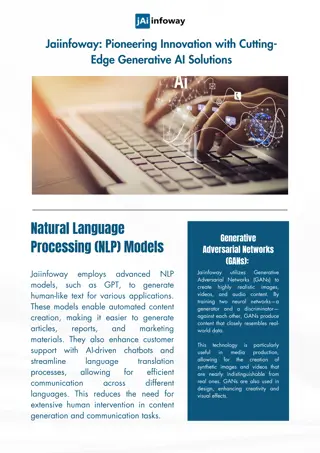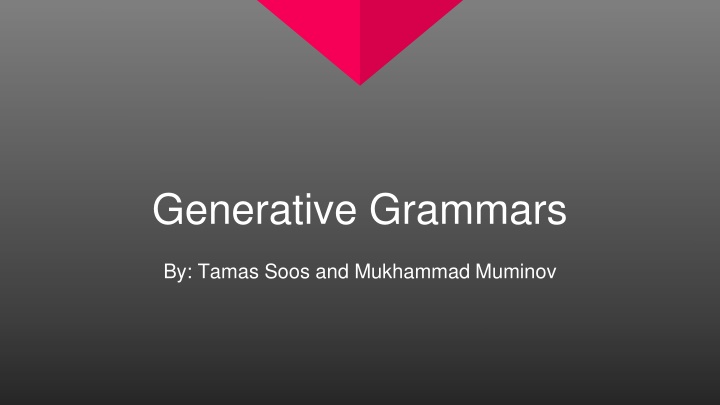
Generative Grammars and Chomsky's Classification
Dive into the world of generative grammars and explore Chomsky's classification of languages based on rule systems. Discover the nuances of phrase-structure languages, context-sensitive languages, and more.
Download Presentation

Please find below an Image/Link to download the presentation.
The content on the website is provided AS IS for your information and personal use only. It may not be sold, licensed, or shared on other websites without obtaining consent from the author. If you encounter any issues during the download, it is possible that the publisher has removed the file from their server.
You are allowed to download the files provided on this website for personal or commercial use, subject to the condition that they are used lawfully. All files are the property of their respective owners.
The content on the website is provided AS IS for your information and personal use only. It may not be sold, licensed, or shared on other websites without obtaining consent from the author.
E N D
Presentation Transcript
Generative Grammars By: Tamas Soos and Mukhammad Muminov
4.2 Classification of Grammars As we could see in earlier examples, we used different grammar descriptions for describing various theoretical problems and languages. Now, let us look at the how the grammars used for defining these grammars, or more precisely languages, differ from each other. In case of two equivalent languages (equivalent grammars) their terminal symbols must be the same. We do not have to prove this, since if the terminal symbols of two languages differ, then it is impossible to generate the same words with them, using the grammar rules. There is no such restriction for nonterminals but if the number of rules differ in two equivalent grammars then possibly the number of nonterminals will also differ. The start symbol is basically irrelevant from this aspect and it can either be the same or differ in the two grammars, since its only role is to start replacement to generate sentences. The most important item is the set of rules in a grammar. This set is where grammars differ a lot. At this point, what is more important is not 4.3. CHOMSKY CLASSIFICATION OF GRAMMARS 37 the set of rules but the form of words that are in the set, since based on that we can differentiate and classify languages (grammars). Considering the form of rules, languages belong to four big groups, into which groups all languages can be classified.
4.3 Chomsky Classification of Grammars Consider a G(V, W, S, P) generative grammar and sentence forms , , (V W) which can also take value and consider an (V W)+ phrasestructure that can not be . We also need the A, B W, nonterminal symbols and the a, b V terminal ones. Based on that we can define the following, regarding the various classes of grammars:
Definition 29 (Phrase-structure Languages) An arbitrary language is type-0 or phrase-structure if every rule generating the language is in the A form. The rule system of phrase-structure languages is very permissive and does not really contain any restrictions on which rules to apply. The languages spoken today belong to this group. Their analysis is very difficult due to the irregularity of rules. Conversion or translation of such languages requires huge resources even for such a complicated automaton as the human brain. In type-0 languages basically there are no restrictions on rules, as the restriction defining that on the left side of the rule system there must be at least on nonterminal symbol, is a restriction that makes the rule system usable.
Definition 30 (Context Sensitive Languages) 30.2 In order to be able to check the correctness of assignment a = 2 written in a general purpose programming language we must know the declaration introducing variable a and the type defined there preceding the assignment a. If the type of the variable is integer, the assignment is correct. If it is not, we found an error, although this instruction is syntactically correct. In type-1 languages it is important that the context of symbols, after replacing the nonterminal symbols, does not change (the subword before and after it) ( and ). The word can only be longer (A and can not be the empty word, so every nonterminal symbol must be replaced with a symbol sequence that is at least the length of 1), so these grammars are called growing grammars.
Definition 30 (Context Sensitive Languages) 30.1 (Context Sensitive Languages) An arbitrary language is type-1 or context sensitive if every rule of the grammar generating the language is in the A form, and the use of rule S is allowed. The rules of context sensitive grammars, like in case of rule A if the phrase-structure that belongs to the left side is given and you want to replace the A nonterminal , then applying any of the rules the beginning of the phrase-structure and the subwords on the left side of the nonterminal A, can not change. To put it differently, to decide if a subword or word is correct we must know its context. This is where the name of the class comes from. Let us have a look at an example.
Definition 31 (Context Free Languages) An arbitrary language is type2 or context free if every rule of the grammar generating the language is in the A form and rule S is allowed.Context free languages, as we could see earlier, are tools of syntax definition and analysis. On the left side of the rules there can only be a nonterminal symbol which lets us define rules of programming languages. Analysis of such languages is relatively easy and fast, due to the freedom of context, since they do not require backtrack. After analyzing the beginning of any text, it can be discarded as the remaining part of the analysis does not depend on the already analyzed part and the part that we have already analyzed is certainly correct. It is important in type-2 languages that on the left side of the rules there can only be one nonterminal symbol which must be replaced with some symbol sequence with the length of at least. Here, we do not have to deal with the context before and after the text, only with the symbol. These grammars can be seen as not length-reducing grammars
Definition 32 (Regular Languages) An arbitrary language is type-3 or regular if every rule of the grammar generating the language is in the A a and A Ba, or A a and A aB form. In the first case we call it right regular language and in the second one we call it left regular language. It is important in type-3 languages that the construction of the word is one way. First, the left side of the word is formed, as during replacement we write a new terminal symbol into the generated word and a new nonterminal one to the right side of the terminal one. In transitional states you can only have one nonterminal symbol and always on the right end of the transitional word.However it is important to have left or right regular rules in a particular grammar, as if both appear in the same grammar then it will not be regular.
The Importance of Chomsky Classification various grammars can be used to solve various analyzing problems Context sensitive grammars are capable of implementing semantic analysis Context free grammars are tools of syntactical analysis, and regular language If we know the type of problem to be solved then we have the key to the solution we do not have to come up with a new solution to every single problem. It is very important to decide if an algorithm created to solve a particular problem of a particular generative grammar can be used to solve the same problem of a different grammar and how to modify it
The Importance of Chomsky Classification If two grammars are in the same Chomsky class, then a sketch of a well- written algorithm, disregarding parameters, will be applicable in theory. It can be proven that there is no general solving algorithms for some problem groups.
Statements Regarding Chomsky Classifications G(V, W, S, P) is a left regular grammar if G0 (V, W0 , S0 , P0 ) right regular grammar, so that L(G) = L(G0 ), namely the language generated by G, and G0 is the same. A K language is type-i (i 0, 1, 2, 3), if there is a G(V, W, S, P) generative grammar that L(G) = K, and the rule system of G is in the in Chomsky class. In case of K2language K is context free, as there is a grammar that is in 2nd Chomsky class and generates K. Multiple generating grammars can belong to the same language Possible for them to belong to different Chomsky classes
Statements Regarding Chomsky Classifications In K2, K is at least context free if we find a grammar that is regular and generates the same language then it can be proven that K is regular The higher class a language can be classified into, the more simple the grammar and the more permissive the language is. Languages are subsets of each other from a certain point of view There are more and more severe restrictions on rules of generating grammars but these do not contradict L3 L2 L1 L0 If language L is type i {0, 1, 2, 3} then L and L{} are also type-i, so in defining the class of a language, has no role. If L1 and L2 are regular languages, then L1 L2 is also regular
Statements Regarding Chomsky Classifications This means that if L1 is regular then there is a G1(V, W1, S1, P1) regular grammar that belongs to it. Similarly there is a regular grammar G2(V, W2, S2, P2) to L2, too W1 and W2 are disjunct sets, so they do not have a common element G1 and G2 are right regular The statement claiming that L1 L2 is regular is easy to prove if we can define a regular grammar that precisely generates the words of L1 L2.
Statements Regarding Chomsky Classifications Consider G3(V, W3, S3, P3) a generative grammar where W3 := W1 W2 {S3}/{S1, S2} it contains terminal symbols of W1 and W2 except for the original S1 and S2 start symbols, and we add a new symbol S3 which will be the start symbol of G3. We should build the rules of S3 W3P3 in a way that we take all the rules in P1 and we replace every S1 with S3, and similarly we take all the rules of P2 and replace every S2 with S3. The G3 above generates the words of L1 L2 precisely since the rule systemP3 created based on the above, can generate words both in L1 and L2 starting from S3.
Statements Regarding Chomsky Classifications If L1 and L2 are regular, then L1 L2 is also regular. If L1 and L2 are regular languages , then L1 L2 is also regular. If L is regular, then L1 is regular. Every finite language is type-3 or regular. There is a type-3 language that is not finite If L is a regular language, then there is a G(V, W, S, P) generative grammar that is regular and generates the L language precisely. We can assume that the rules in P are right regular and every rule is in form S a, S Ba.
Chomsky Normal Form A G(V,W,S,P) generative grammar is in Chomsky normal form if every rule in P is in form A BC or A a (where A, B, C W, a V ). An "A" nonterminal can be unnecessary for two reasons: "A" can not be introduced into a phrase-structure, so there is no rule sequence that starts from "S" phrase symbol and ends in the A phrase from (e.g.: with some a, b (V W) words). We can not terminate from "A", so there is no such a V , so that A a exists.
Chomsky Normal Form The unnecessary nonterminals that belong to the first group can be defined as follows in a G = (V, W, S, P) grammar: Consider U0 = {S} and Ui + 1 = Ui {A| BaAb P, A W, B Ui , a, b (V W) },(i >= 0). Since W is finite, there is an i so that Ui = Ui + 1. Then nonterminals W Ui are unnecessary because they can not be reached with derivations starting in S
Chomsky Normal Form The unnecessary nonterminals of the second group in a G = (V, W, S, P) grammar can be defined in the following (recursive) way: Consider U0= {A|considerA a P, A W, a V } and Ui+ 1 = Ui {A| A b P, A W, b (Ui V ) },(i >= 0). Due to the finite W, there is an i, so that Ui= Ui+ 1, and then the W Ui nonterminals are unnecessary because it is not possible to derive a terminal subword (or empty) from them. If S is not in set Ui, the generated language is empty.
Chomsky Normal Form A context free grammar is in Chomsky normal form if its every rule is in form A a or A BC where A, B, C W and a V . Every -free context free language can be generated by a grammar that is in Chomsky normal form, or else there is an equivalent context free grammar in normal form to every G context free grammar Every, at least type-2 (context free) Chomsky class grammar can be modified to be in Chomsky normal form.

